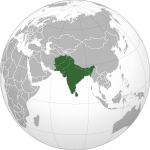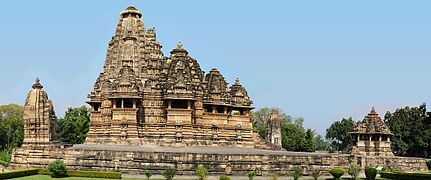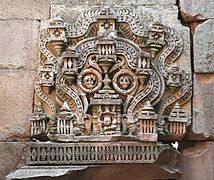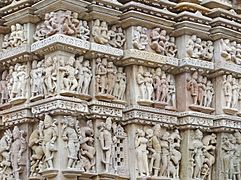Chandelas of Jejakabhukti (Chandel Empire)
Chandelas of Jejakabhukti Chandel dynasty of Jejakabhukti | |||||||||||||
|---|---|---|---|---|---|---|---|---|---|---|---|---|---|
| 832 CE–14th CE | |||||||||||||
Coinage of Sallakshanavarman (1120–1135 CE), Chandelas of Jejakabhukti
| |||||||||||||
![Chandela dynasty map [1][2]](https://upload.wikimedia.org/wikipedia/commons/thumb/9/98/Map_of_Candellas_around_1200_CE.jpg/290px-Map_of_Candellas_around_1200_CE.jpg) | |||||||||||||
| Capital | |||||||||||||
| Common languages | Sanskrit | ||||||||||||
| Religion | Official Shaivism Some Vaishnavism | ||||||||||||
| Government | Monarchy | ||||||||||||
| Emperor (Kalanjaradhipati) | |||||||||||||
• 832-845 CE | Chandravarman (First ruler) | ||||||||||||
• 1165-1203 CE | Paramardivarman I (Last emperor) | ||||||||||||
• | unclear | ||||||||||||
| Historical era | Medieval India | ||||||||||||
• Established | 832 CE | ||||||||||||
• Rise of Empire | 9th CE | ||||||||||||
• Fall of Empire | 1203 CE | ||||||||||||
• Disestablished | 14th CE | ||||||||||||
| Currency | Hanumana[3] Goddess Laxmi[4] | ||||||||||||
| |||||||||||||
| Today part of | India | ||||||||||||
The Chandelas of Jejakabhukti (Devanagri: जेजाकभुक्ति के चन्देल, colloquially known as the Chandela dynasty [5][6] or Chandel Empire[7]) were an Indian dynasty of Jejakabhukti which was founded by a Chandravanshi (Chandel) ruler Chandravarman. They ruled many parts of India from the 8th to 14th centuries,[8] and repulsed many Muslim invasions. They are renowned notably known for their art, architecture and temples. They commissioned a number of temples, water bodies, palaces and forts. They were the most prominent ruling family of the Chandel Rajput clan.[9]
Chandravarman I (Nannuka-Varman) founded Chandravanshi (Chandel) dynasty of Khajuraho around 835 AD. The Chandel Emperors like Vakpati Varman, Rahila Varman, Yashovarman I, and Dhanga Varman subdued the kings as far as Simhala (Sri Lanka) by doing Ashvamedha Yajna or Digvijayas. The Chandels achieved significant victories over various neighbour dynasties like Chalukyas of Gujrat Paramaras of Malwa, Kalachuris of Tripuri, Eastern Gangas and Somvanshi of Kalinga and Koshala etc., subjugating them to their Empire. Although some kingdoms occasionally rebelled and gained independence, the Chandels swiftly defeated and re-subjugated them. The Chalukyas of Gujrat and some southern Indian kingdoms used to pay homage to the Chandels.
In 1203 AD, the Ghurid invasion ended the Chandel dynasty in a war, in they and their emperor Paramardivarman displayed indomitable bravery and resistance, but was killed. However, in 1206 AD, Paramardi Varman's younger son Trailokya Varman revived the dynasty by defeating the Muslim governor of Kalanjara, and the iltutmish, Sultan of Delhi, thereby restoring the Chandels' power and prestige. He then went on to expand Chandel sovereignty over Central and East Indian kingdoms, ushering in a period of renewed dominance that lasted until 14th century AD.
The Chandelas were primarily followers of Shaivism but were tolerant of Vaishnavism, Buddhism and Jainism. The Chandels were staunchly religious; they were anxious not to violate dharma and sacred law in any way. In several Chandel inscriptions, there are references to many kings who were afraid to offend against the religious law. The Chandels often emphasized the positive duty of following the state through dharma, which was the duty of a Kshatriya ruler.[10][11][12][13] The Chandel rulers were very often guided and very supported by Brahmin ministers, big scholars and counsellors.[14]
Origin[edit]
The origin of the Chandelas is obscured by mythical legends. The epigraphic records of the dynasty, as well as contemporary texts such as Balabhadra-vilasa and Prabodha-chandrodaya, suggest that the Chandelas belonged to the legendary Lunar dynasty (Chandravansha).[15] A 954 CE Khajuraho inscription states that the dynasty's first king Nannuka was a descendant of sage Chandratreya, who was a son of Atri. A 1002 CE Khajuraho inscription gives a slightly different account, in which Chandratreya is mentioned as a son of Indu (the Moon) and a grandson of Atri.[16] The 1195 CE Baghari inscription and the 1260 CE Ajaygadh inscription contain similar accounts.[17] The Balabhadra-vilasa also names Atri among the ancestors of the Chandelas. Another Khajuraho inscription describes the Chandela king Dhanga as a member of the Vrishni clan of the Yadavas (who also claimed to be part of the Lunar dynasty).[15]

The Mahoba-Khanda legend of the dynasty's origin goes like this: Hemaraja, a priest of the Gaharwar king of Benares, had a beautiful daughter named Hemavati. Once, while Hemavati was bathing in a pond, the moon god Chandra saw her and made love to her. Hemavati was worried about the dishonour of being an unwed mother, but Chandra assured her that their son would become a great king. This child was the dynasty's progenitor Chandravarma. Chandra presented him with a philosopher's stone and taught him politics.[18][15] The dynasty's own records do not mention Hemavati, Hemaraja or Indrajit. Such legends appear to be later bardic inventions. In general, the Mahoba-Khanda is a historically unreliable text.[16] Prithviraj Raso is also considered an historically unreliable text.[19][20][21]

British indologist V. A. Smith theorized that the Chandelas were of either Bhar or Gond origin. Some other scholars including R. C. Majumdar also supported this theory.[22] The Chandelas worshipped Maniya, a tribal goddess, whose temples are located at Mahoba and Maniyagadh.[23] Besides, they have been associated with places that are also associated with Bhars and Gonds. Also, Rani Durgavati, whose family claimed Chandela descent married a Gond chief of Garha-Mandla.[24] Historian R. K. Dikshit does not find these arguments convincing: he argues that Maniya was not a tribal deity.[25] Also, the dynasty's association with Gond territory is not necessarily indicative of a common descent: the dynasty's progenitor may have been posted as a governor in these territories.[24] Finally, Durgavati's marriage to a Gond chief can be dismissed as a one-off case.[25]
History[edit]
Early rulers[edit]
The early Chandelas were originally vassals of the Gurjara-Pratiharas.[26] Nannuka (r. c. 831-845 CE), the founder of the dynasty, was the ruler of a small kingdom centered around Khajuraho.[27]
According to the Chandela inscriptions, Nannuka's successor Vakpati defeated several enemies.[28] Vakpati's sons Jayashakti (Jeja) and Vijayashakti (Vija) consolidated the Chandela power.[29] According to a Mahoba inscription, the Chandela territory was named "Jejakabhukti" after the Jayashakti.[30] Vijayashakti's successor Rahila is credited with several military victories in eulogistic inscriptions.[31] Rahila's son Harsha played an important role in restoring the rule of the Pratihara king Mahipala, possibly after a Rashtrakuta invasion or after Mahiapala's conflict with his step-brother Bhoja II.[32]
Rise as a sovereign power[edit]

Harsha's son Yashovarman (r. c. 925-950 CE) continued to acknowledge the Pratihara suzerainty, but became practically independent.[33] He conquered the important fortress of Kalanjara.[34] A 953-954 CE Khajuraho inscription credits him with several other military successes, including against Gaudas (identified with the Palas), the Khasas, the Chedis (the Kalachuris of Tripuri), the Kosalas (possibly the Somavamshis), the Mithila (possibly a small tributary ruler), Malavas (identified with the Paramaras), the Kurus, the Kashmiris and the Gurjaras.[35] These claims appear to be exaggerated, as similar claims of extensive conquests in northern India are also found in the records of the other contemporary kings such as the Kalachuri king Yuva-Raja and the Rashtrakuta king Krishna III.[36] Yashovarman's reign marked the beginning of the famous Chandela-era art and architecture. He commissioned the Lakshmana Temple at Khajuraho.[34]
Unlike the earlier Chandela inscriptions, the records of Yashovarman's successor Dhanga (r. c. 950-999 CE) do not mention any Pratihara overlord. This indicates that Dhanga formally established the Chandela sovereignty.[37] A Khajuraho inscription claims that the rulers of Kosala, Kratha (part of Vidarbha region), Kuntala, and Simhala listened humbly to the commands of Dhanga's officers. It also claims that the wives of the kings of Andhra, Anga, Kanchi and Raḍha resided in his prisons as a result of his success in wars. These appear to be eulogistic exaggerations by a court poet, but suggest that Dhanga did undertake extensive military campaigns.[38][39] Like his predecessor, Dhanga also commissioned a magnificent temple at Khajuraho, which is identified as the Vishvanatha Temple.[40]
Dhanga's successor Ganda appears to have retained the territory he inherited.[41] His son Vidyadhara killed the Pratihara king of Kannauj (possibly Rajyapala) for fleeing his capital instead of fighting the Ghaznavid invader Mahmud of Ghazni.[42][43] Mahmud later invaded Vidyadhara's kingdom; according to the Muslim invaders, this conflict ended with Vidyadhara paying tribute to Mahmud.[44] Vidyadhara is noted for having commissioned the Kandariya Mahadeva Temple.[45]
The Chandela art and architecture reached its zenith during this period. The Lakshmana Temple (c. 930–950 CE), the Vishvanatha Temple (c. 999-1002 CE) and the Kandariya Mahadeva Temple (c. 1030 CE) were constructed during the reigns of Yashovarman, Dhanga and Vidyadhara respectively. These Nagara-style temples are representative of the most fully developed style at Khajuraho.[46]
- Nagara-style temples of Khajuraho
Decline[edit]

By the end of Vidyadhara's reign, the Ghaznavid invasions had weakened the Chandela kingdom. Taking advantage of this, the Kalachuri king Gangeya-deva conquered eastern parts of the kingdom.[47] Chandela inscriptions suggest that Vidyadhara's successor Vijayapala (r. c. 1035-1050 CE) defeated Gangeya in a battle.[48] However, the Chandela power started declining during the Vijayapala's reign.[49] The Kachchhapaghatas of Gwalior probably gave up their allegiance to the Chandelas during this period.[50]
Vijayapala's elder son Devavavarman was subjugated by Gangeya's son Lakshmi-Karna.[51] His younger brother Kirttivarman resurrected the Chandela power by defeating Lakshmi-Karna.[52] Kirtivarman's son Sallakshanavarman achieved military successes against the Paramaras and the Kalachuris, possibly by raiding their territories. A Mau inscription suggests that he also conducted successful campaigns in the Antarvedi region (the Ganga-Yamuna doab).[53] His son Jayavarman was of religious temperament and abdicated the throne after being tired of governance.[54]
Jayavarman appears to have died heirless, as he was succeeded by his uncle Prithvivarman, the younger son of Kirttivarman.[55] The Chandela inscriptions do not ascribe any military achievements to him; it appears that he was focused on maintaining the existing Chandela territories without adopting an aggressive expansionist policy.[56]
Revival[edit]
By the time Prithvivarman's son Madanavarman (r. c. 1128–1165 CE) ascended the throne, the neighbouring Kalachuri and Paramara kingdoms had been weakened by enemy invasions. Taking advantage of this situation, Madanavarman defeated the Kalachuri king Gaya-Karna, and subjected him.[57] However, the Chandel's governor lost this territory to Gaya-Karna's successor Narasimha.[58] Madanavarman also captured the territory on the western periphery of the Paramara kingdom, around Bhilsa (Vidisha) and later subjected whole paramara kingdom. This probably happened during the reign of the Paramara king Yashovarman or his son Jayavarman.[59][60]
Jayasimha Siddharaja, the Chaulukya king of Gujarat, also invaded the Paramara territory, which was located between the Chandel and the Chaulukya kingdoms. This brought him in conflict with Madanavarman.[61] A Kalanjara inscription suggests that Madanavarman defeated Jayasimha. The self pro-claimed various chronicles of Chaulukyas claimed that Jayasimha either defeated Madanavarman or extracted a tribute from him.[62] Madanavarman defeated a Gahadavala ruler Govindchandra, in which Govindchandra fled from his capital to save his life. Later on the request of Govindchandra, Madanavarman returned his kingdom to him and both became friendly state.[63]
Madanavarman's son Yashovarman II ruled for a very short time and died in a war. Aftter Yashovarman II, his son Paramardivarman deva become chandel emperor.[64]
Final decline[edit]
Paramardivarman Deva (reigned c. 1165-1203 CE) ascended the Chandel throne at the age of 5. QllIn 1182 CE, Paramardivarman defeated Chauhan king Prithviraj III in battle and repulsed his raid.[65][66][67]. But to avoid the humiliation of their king, the 16th c Chauhans claimed in ballads, that the Chandels were defeated and Parmardivarman committed suicide around 1185-86 A.D.
This is corroborated by his stone inscriptions at Madanpur[67] However, the occupation of Mahoba or Kalanjara by Chauhans is not supported by historical evidence. Not even by madanpur inscription of Prithviraj Chauhan, that was mere a small raid which was successfully repulsed by Paramardivarman Deva.[68] He is known to have issued several inscriptions after this event: the Kalanjara rock inscription, the 1184 CE Mahoba stone inscription, the 1187 CE Ajaygarh stone inscription, the 1195 CE Baghari (Bateshvar) stone inscription, and the 1201 CE Kalanjara stone inscription.[69] These records give imperial titles for Paramardivarman, indicating that he remained a sovereign Emperor.[70] The Muslim chronicles also provide evidence that Paramardivarman ruled the empire until the beginning of the next century, when the Delhi Sultanate invaded the Chandel empire.[68]. He is known to have issued several inscriptions after this event: the Kalanjara rock inscription, the 1184 CE Mahoba stone inscription, the 1187 CE Ajaygarh stone inscription, the 1195 CE Baghari (Bateshvar) stone inscription, and the 1201 CE Kalanjara stone inscription.[69] These records give imperial titles for Paramardivarman, indicating that he remained a sovereign ruler.[70] The Muslim chronicles also provide evidence that Paramardivarman ruled until the beginning of the next century, when the Delhi Sultanate invaded the Chandel kingdom.[68]
The 1195 CE Bateshvar inscription states that other feudatory kings bowed before him, and the 1201 CE Kalanjara inscription describes him as the lord of Dasharna country.
The Chandel power did not fully recover from their defeat against the Delhi forces. Paramardivarman was succeeded by Trailokyavarman, Viravarman and Bhojavarman. Hammiravarman defeated Allauddin khalji.
Hammiravarman was succeeded by Viravarman II, whose titles do not indicate a high political status.[71][72] Durgavati was married to Dalpat Shah, the adopted son of the king Sangram Shah of the Garha Kingdom. According to Abul Fazl, Dalpat Shah was the son of a Kachhwaha Rajput adopted by Raja of Gadha mandla.[73][74] The Chandel of mahoba and Garha Kingdom dynasty (Garha Mandla) dynasties were allied because of this marriage.[75] [76] [75] Some other ruling families also claimed Chandela descent (see Chandel).
Art and architecture[edit]
The Chandelas are well known for their art and architecture. They commissioned a number of temples, water bodies, palaces and forts at various places. The most famous example of their cultural achievements are the Hindu and Jain temples at Khajuraho. Three other important Chandela strongholds were Jayapura-Durga (modern Ajaigarh), Kalanjara (modern Kalinjar) and Mahotsava-Nagara (modern Mahoba).[77]
- Chandela architecture
Other smaller Chandela sites include Chandpur, Deogarh, Dudahi, Kakadeo and Madanpur.[77]
- Chandela sculptures
Jain tirthankaras and Sarasvati, Ajaigarh
Jain shramanas, Ajaigarh
Surasundari Apsara, Khajuraho
Parshvanatha temple carvings
Lakshmana temple carvings
List of rulers[edit]

Based on epigraphic records, the historians have come up with the following list of Chandela rulers of Jejākabhukti (IAST names in brackets):[79][80]
- Chandravarman II, c. 831-845 CE
- Vakpativarman (Vākpati), c. 845-865 CE
- Jayashaktivarman (Jayaśakti) and Vijayashaktivarman (Vijayaśakti), c. 865-885 CE
- Rahilavarman (Rāhila), c. 885-905 CE
- Shri Harshavarman (Śri Harśa), c. 905-925 CE
- Yashovarman (Yaśovarman), c. 925-950 CE
- Dhangavarman (Dhaṅgavarman), c. 950-999 CE
- Gandavarmam (Gaṇḍavarman), c. 999-1002 CE
- Vidyadharavarman (Vidyādharavarman), c. 1003-1035 CE
- Vijayapalavarman (Vijayapāla), c. 1035-1050 CE
- Devavarman, c. 1050-1060 CE
- Kirttivarman I (Kīrtivarman), c. 1060-1100 CE
- Sallakshanavarman (Sallakṣaṇavarman), c. 1100-1110 CE
- Jayavarman, c. 1110-1120 CE
- Prithvivarman (Pṛthvīvarman), c. 1120-1128 CE
- Madanavarman, c. 1128-1165 CE
- Yashovarman II (c. 1164-65 CE); did not rule or ruled for a very short time
- Paramardivarman I, c. 1165-1203 CE
- Trailokyavarman, c. 1203-1245 CE
- Viravarman (Vīravarman), c. 1245-1285 CE
- Bhojavarman, c. 1285-1288 CE
- Hammiravarman (Hammīravarman), c. 1288-1311 CE
- Viravarman II (an obscure ruler with low titles, attested by only one 1315 CE inscription)[71]
References[edit]
| Outline of South Asian history |
|---|
 |
- ↑ Singh 1984, p. 69.
- ↑ Gvāliyara darśana - Volume 1 -, 1980 & sfn.
- ↑ Roy, Prafulla Chandra (1980). The Coinage of Northern India: The Early Rajaputa Dynasties from the 11th to the 13th Centuries A.D. Abhinav Publications. ISBN 978-81-7017-122-5.
- ↑ Husaini (Saiyid.), Abdul Qadir (1962). The Economic History of India. Eastern Publishers.
- ↑ Raychaudhuri, Tapan; Habib, Irfan; Kumar, Dharma (1982). The Cambridge Economic History of India: Volume 1, C.1200-c.1750. CUP Archive. ISBN 978-0-521-22692-9.
- ↑ Cunningham, Sir Alexander (1891). Coins of Ancient India from the Earliest Times Down to the Seventh Century A.D. Quaritch.
- ↑ Gangoly, Ordhendra Coomar (1957). The Art of the Chandelas. Rupa.
- ↑ sakalle, Jairam Sitaram Pawar & Vinayak (13 June 2023). Raja Bhoj Parmaron Ki Gorvanshiya Virasat (in हिन्दी). Blue Rose Publishers.
- ↑ *Upinder Singh (2004). The Discovery of Ancient India: Early Archaeologists and the Beginnings of Archaeology. Permanent Black. p. 73. ISBN 978-81-7824-088-6.
Discussion of the histories of various Rajput clans, such as the Chauhans, Kachhvahas, Chandelas, Pratiharas and Tomaras on the basis of a wide range of sources-literary, epigraphic, numismatic, bardic accounts and local traditions
- Kulke, Hermann; Rothermund, Dietmar (2004). A History of India. Psychology Press. p. 117. ISBN 978-0-415-32919-4.
When Gurjara Pratiharas power declined after the sacking of Kannauj by the Rashtrakutas in the early tenth century many Rajput princes declared their independence and founded their own kingdoms, some of which grew to importance in the subsequent two centuries. The better known among those dynasties were the Chaulukyas or Solankis of Gujarat and Kathiawar, the Chahamanas (i.e. Chauhans) of eastern Rajasthan (Ajmer and Jodhpur) and the Tomaras who had founded Delhi (Dhillika) in 736 but had been displaced by the Chauhans in the twelfth century. Rajput descent was also claimed by the Chandelas of Khujuraho and the Kalachuris of Tripuri
- Romila Thapar (2004). Early India: From the Origins to AD 1300. University of California Press. p. 420. ISBN 978-0-520-24225-8.
Other claiming to be Rajputs and descended from the solar and lunar lines, established themselves as local kings in various parts of western and central India. Among them were the Chandellas, prominent in the tenth century in Bundelkhand with their centre at Khajuraho and their territory known as Jejakabhukti
- R. K. Dikshit 1976, pp. 8: "The Candellas are undoubtedly a Rajput clan and the epigraphic evidences does not show that any inferiority was applied to them in the past. It reveals their matrimonial relationship with important Rajput families from the very beginning of their history"
- Kulke, Hermann; Rothermund, Dietmar (2004). A History of India. Psychology Press. p. 117. ISBN 978-0-415-32919-4.
- ↑ Banerjee, Anil Chandra (1962). Lectures on Rajput History. Firma K.L. Mukhopadhyay.
- ↑ Banerjee, Anil Chandra (1983). Aspects of Rajput State and Society. Rajesh Publications.
- ↑ Encyclopaedia Indica: India, Pakistan, Bangladesh. Anmol Publications. 1996. ISBN 978-81-7041-859-7.
- ↑ Bakshi, S. R.; S.G (2005). Early Aryans to Swaraj. Sarup & Sons. ISBN 978-81-7625-537-0.
- ↑ Mitra, Sisir Kumar (1977). The Early Rulers of Khajur (Second Revised Edition). Motilal Banarsidass Publ. ISBN 978-81-208-1997-9.
- ↑ 15.0 15.1 15.2 R. K. Dikshit 1976, p. 3.
- ↑ 16.0 16.1 R. K. Dikshit 1976, p. 4.
- ↑ R. K. Dikshit 1976, p. 5.
- ↑ Jai Narayan Asopa (1976). Origin of the Rajputs. Bharatiya Publishing House. p. 208.
- ↑ Vijayendra Snatak (1997). "Medieval Hindi Literature". In K Ayyappap Panikkar (ed.). Medieval Indian literature: an anthology (Volume 1). Sahitya Akademi. p. 142. ISBN 978-81-260-0365-5. Retrieved 28 September 2011.
- ↑ Freitag, Jason (2009). Serving empire, serving nation: James Tod and the Rajputs of Rajasthan. BRILL. pp. 3–5. ISBN 978-90-04-17594-5.
- ↑ R. V. Somani (1976). History of Mewar, from Earliest Times to 1751 A.D. Mateshwari. p. 30. OCLC 2929852.
- ↑ R. K. Dikshit 1976, p. 6.
- ↑ Ali Javid and Tabassum Javeed (2008). World Heritage Monuments and Related Edifices in India. Vol. 1. Algora. p. 44. ISBN 9780875864822.
- ↑ 24.0 24.1 R. K. Dikshit 1976, p. 7.
- ↑ 25.0 25.1 R. K. Dikshit 1976, p. 8.
- ↑ Radhey Shyam Chaurasia, History of Ancient India: Earliest Times to 1000 A. D.
- ↑ Sailendra Sen (2013). A Textbook of Medieval Indian History. Primus. p. 22. ISBN 978-93-80607-34-4.
- ↑ Sisirkumar Mitra 1977, pp. 27-28.
- ↑ Sisirkumar Mitra 1977, p. 30.
- ↑ R. K. Dikshit 1976, p. 28.
- ↑ R. K. Dikshit 1976, pp. 30-31.
- ↑ R. K. Dikshit 1976, pp. 32-35.
- ↑ Sisirkumar Mitra 1977, pp. 36-37.
- ↑ 34.0 34.1 Sushil Kumar Sullerey 2004, p. 24.
- ↑ Sisirkumar Mitra 1977, p. 42-51.
- ↑ R. K. Dikshit 1976, p. 42.
- ↑ Sisirkumar Mitra 1977, p. 57.
- ↑ R. K. Dikshit 1976, p. 56.
- ↑ Sisirkumar Mitra 1977, pp. 61-65.
- ↑ R. K. Dikshit 1976, p. 69.
- ↑ Sisirkumar Mitra 1977, pp. 72.
- ↑ Sisirkumar Mitra 1977, pp. 72-73.
- ↑ R. K. Dikshit 1976, p. 72.
- ↑ Sisirkumar Mitra 1977, pp. 81-82.
- ↑ Sushil Kumar Sullerey 2004, p. 26.
- ↑ James C. Harle (1994). The Art and Architecture of the Indian Subcontinent. Yale University Press. p. 234. ISBN 0300062176.
- ↑ Sisirkumar Mitra 1977, pp. 89-90.
- ↑ Sisirkumar Mitra 1977, p. 88.
- ↑ R. K. Dikshit 1976, p. 101.
- ↑ Sisirkumar Mitra 1977, p. 90.
- ↑ Sisirkumar Mitra 1977, p. 91.
- ↑ Sisirkumar Mitra 1977, p. 94.
- ↑ R. K. Dikshit 1976, p. 120-121.
- ↑ R. K. Dikshit 1976, p. 126.
- ↑ Sisirkumar Mitra 1977, pp. 110-111.
- ↑ Sisirkumar Mitra 1977, p. 111.
- ↑ R. K. Dikshit 1976, p. 132.
- ↑ R. K. Dikshit 1976, p. 135.
- ↑ R. K. Dikshit 1976, pp. 130-132.
- ↑ Sisirkumar Mitra 1977, p. 112-113.
- ↑ R. K. Dikshit 1976, p. 133.
- ↑ R. K. Dikshit 1976, pp. 133-134.
- ↑ R. K. Dikshit 1976, p. 132-133.
- ↑ R. K. Dikshit 1976, p. 130.
- ↑ Mohinder Singh Randhawa & Indian Council of Agricultural Research 1980, pp. 472.
- ↑ M.S. Randhawa & Indian Sculpture: The Scene, Themes, and Legends 1985, pp. 532.
- ↑ 67.0 67.1 Sisirkumar Mitra 1977, p. 123.
- ↑ 68.0 68.1 68.2 Sisirkumar Mitra 1977, p. 125.
- ↑ 69.0 69.1 Sisirkumar Mitra 1977, p. 124.
- ↑ 70.0 70.1 Sisirkumar Mitra 1977, p. 126.
- ↑ 71.0 71.1 Peter Jackson 2003, p. 199.
- ↑ Om Prakash Misra 2003, p. 11.
- ↑ Dikshit, R. K. (1976). The Candellas of Jejākabhukti. Abhinav Publications. p. 8. ISBN 978-81-7017-046-4.
- ↑ Abul Fazl, Henry Beveridge (1907). Akbarnama Vol-2. p. 326.
- ↑ 75.0 75.1 Archana Garodia Gupta (20 April 2019). The Women Who Ruled India- Leaders. Warriors. Icons (Ebook). Hachette India. ISBN 9789351951537.
- ↑ Romila Thapar 2013, p. 572.
- ↑ 77.0 77.1 Sushil Kumar Sullerey 2004, p. 17.
- ↑ Harihar Vitthal Trivedi 1991, pp. 335-552.
- ↑ R. K. Dikshit 1976, p. 25.
- ↑ Sushil Kumar Sullerey 2004, p. 25.
Bibliography[edit]
- Harihar Vitthal Trivedi (1991). Inscriptions of the Paramāras (Part 2). Corpus Inscriptionum Indicarum Volume VII: Inscriptions of the Paramāras, Chandēllas, Kachchapaghātas, and two minor dynasties. Archaeological Survey of India.
- Om Prakash Misra (2003). Archaeological Excavations in Central India: Madhya Pradesh and Chhattisgarh. Mittal Publications. ISBN 978-81-7099-874-7.
- Peter Jackson (2003). The Delhi Sultanate: A Political and Military History. Cambridge University Press. ISBN 978-0-521-54329-3.
- R. K. Dikshit (1976). The Candellas of Jejākabhukti. Abhinav. ISBN 9788170170464.
- Romila Thapar (2013). The Past Before Us. Harvard University Press. ISBN 978-0-674-72651-2.
- Sisirkumar Mitra (1977). The Early Rulers of Khajurāho. Motilal Banarsidass. ISBN 9788120819979.
- Sushil Kumar Sullerey (2004). Chandella Art. Aakar Books. ISBN 978-81-87879-32-9.


















